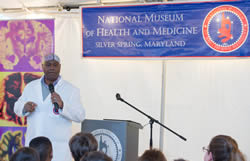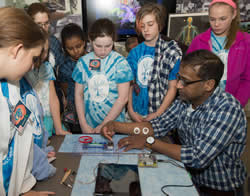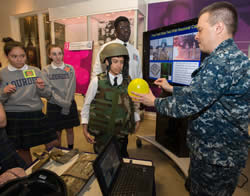Medical Museum Hosts 2016 "Brain Awareness Week"
By Daniel Daglis
National Museum of Health and Medicine
"Who we are is dependent on how healthy we keep our brains," is one lesson Dr. Michael Oshinsky from the National Institute of Neurological Disorders and Stroke relayed to a group of middle-school students during Brain Awareness Week (BAW) at the National Museum of Health and Medicine (NMHM) in Silver Spring, Maryland last month.
Oshinsky described the story of Phineas Gage, a railroad foreman in 1848 who famously survived an accident after a railroad spike was propelled through his skull. Although Gage survived without major physical handicap, the damage to the frontal lobe of his brain turned him into a completely different person, earning him the reputation as the most unpleasant man in town.
Brain health is so vital to a person's overall health that Virginia Gov. Terence R. McAuliffe and District of Columbia Mayor Muriel Bowser proclaimed March 14 – 20, 2016, Brain Awareness Week in their jurisdictions.
BAW, now in its 17th year at NMHM, is an annual event bringing together middle-school students from the greater Washington, D.C., area with presenters from many different universities, government agencies and military medical research organizations dealing with matters concerned with brain sciences. BAW was created by the Dana Alliance for Brain Initiatives, which coordinates an international array of activities to raise interest in neuroscience.
"Brain Awareness Week exists to inspire interest in brain sciences in the minds of our young visitors, so that we may someday see them develop into a new generation of neuroscientists," said Andrea Schierkolk, NMHM public programs manager. "Partnering with some of the most cutting-edge brain science research organizations in the country, Brain Awareness Week at NMHM highlights research and advances from those individual agencies and promotes this field as a career option."
A common theme during BAW week at NMHM was the proper management of traumatic brain injuries (TBI). The Department of Defense (DoD) has demonstrated a commitment to treating and preventing TBI. As a DoD museum, NMHM features a major exhibit showcasing several types of traumatic brain injuries including hemorrhages, blunt force trauma and bullet wounds.
Personnel from the Naval Medical Research Center (NMRC) demonstrated recent advancements in protecting military service members from TBI. One innovation is the development of sensors that can be placed on personal protective equipment to record overpressure and acceleration experienced during a blast, to learn how overpressure affects the brain. Data from these sensors may help inform medical diagnostic techniques and help improve body armor and helmets.
At a Defense and Veterans Brain Injury Center (DVBIC) station, students learned about a very practical way for everyday citizens to protect themselves from a TBI: a helmet. Students dropped chicken eggs from a ladder to simulate what happens when a person is (or is not) wearing protective gear during a traumatic event such as a bicycle accident. They repeated the exercise after devising simple protective padding for the eggs, to see the contrast offered by wearing a helmet as a means of protecting the head and brain.
Keeping the brain healthy and free from injury was not the only thing that students learned during BAW. A recurring lesson throughout the week was how the brain actually works. At one station, Distinguished Professor of Psychology, Dr. Barry Komisaruk from Rutgers University, gave students an interesting look at how the brain perceives different images while presenting them with a variety of brain teasers, and discussing the science behind why things are not always as they seem.
The National Institute of Mental Health (NIMH) allowed students to observe recordings of the electrical activity generated by muscles in their arms and fingers to gain a deeper understanding of the extent of the human nervous system. This same electrical activity caused by the brain is what is used to stimulate robotic prosthetics; which is exactly what students were allowed to do while controlling a robotic hand to pick up a coffee cup using only the electric impulses from the movement of their hand.
Additional NMHM Partners in Education and presenters for the 2016 Brain Awareness Week included:
- Congressionally Directed Medical Research Programs/USAMRMC
- Howard University
- National Institutes of Health, including:
- Society for Neuroscience, D.C. Metro Area Chapter
- Uniformed Services University of the Health Sciences
- Walter Reed Army Institute of Research
- Walter Reed National Military Medical Center, National Military Audiology and Speech Pathology Center, Audiology Section

|
Caption:
Archie Fobbs, National Museum of Health and Medicine (NMHM) Neuroanatomical Collections manager, greets students at the beginning of Brain Awareness Week, held March 14-18, 2016, at NMHM, in Silver Spring, Maryland. The event, now in its 17th year, brings together Washington, D.C. - area students and neuroscientists from the Department of Defense and other NMHM Partners in Education. (National Museum of Health and Medicine photo by Matthew Breitbart / Released) |

|
Caption:
Students learned how muscles generate electrical activity to gain deeper understanding of the nervous system with the National Institute of Mental Health on March 17, 2016, during Brain Awareness Week. Now in its 17th year, Brain Awareness Week, held March 14-18, 2016, at the National Museum of Health and Medicine (NMHM), in Silver Spring, Maryland, brings together Washington, D.C. - area students and neuroscientists from the Department of Defense and other NMHM Partners in Education. (National Museum of Health and Medicine photo by Matthew Breitbart / Released) |

|
Caption:
Service members from the Naval Medical Research Center discussed the effects of blasts on the brain, and brought protective gear for students to try on March 17, 2016, during Brain Awareness Week. Now in its 17th year, Brain Awareness Week, held March 14-18, 2016, at the National Museum of Health and Medicine (NMHM), in Silver Spring, Maryland, brings together Washington, D.C. - area students and neuroscientists from the Department of Defense and other NMHM Partners in Education. (National Museum of Health and Medicine photo by Matthew Breitbart / Released) |

|
Caption:
Staff from the Walter Reed National Military Medical Center Audiology Clinic uses a tuning fork while introducing students to the auditory system and leading them through a demonstration on how the vestibular system affects balance on March 18, 2016, during Brain Awareness Week. Now in its 17th year, Brain Awareness Week, held March 14-18, 2016, at the National Museum of Health and Medicine (NMHM), in Silver Spring, Maryland, brings together Washington, D.C. - area students and neuroscientists from the Department of Defense and other NMHM Partners in Education. (National Museum of Health and Medicine photo by Matthew Breitbart / Released) |
About the National Museum of Health and Medicine:
The National Museum of Health and Medicine, a Department of Defense museum established in 1862 as the Army Medical Museum, inspires interest in and promotes the understanding of medicine -- past, present and future -- with a special emphasis on tri-service American military medicine. As a National Historic Landmark recognized for its ongoing value to the health of the military and to the nation, NMHM identifies, collects, and preserves important and unique resources to support a broad agenda of innovative exhibits, educational programs, and scientific, historical, and medical research. NMHM is an element of the Research, Development and Acquisitions Directorate of the Defense Health Agency, Falls Church, Virginia.
NMHM is located at 2500 Linden Lane, Silver Spring, MD, 20910, and is open daily (including weekends and holidays) from 10 a.m. to 5:30 p.m. Visit the website or call (301) 319-3300 for information on tour programs and special events.
NMHM on the web: www.medicalmuseum.mil
NMHM on Facebook: www.facebook.com/MedicalMuseum
NMHM on Twitter: www.twitter.com/MedicalMuseum
NMHM on Instagram: www.instagram.com/medicalmuseum



